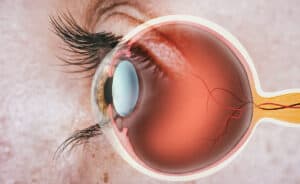Corneal transplants are used to correct vision when the corneal tissue has been significantly damaged. During the procedure, a full or partial thickness of corneal tissue is removed and replaced with donor tissue. Dr. Brian Boxer Wachler has specialty fellowship training in corneal surgery, and in the past has used corneal transplant surgery to help many Los Angeles patients, as well as patients from across the U.S. and around the world, to preserve and recover vision.
When Are Corneal Transplants Needed?
The corneal transplant procedure is reserved for patients who corneal tissue has deteriorated to the extent that it cannot heal, and vision is being significantly affected. The conditions that can require this surgery include:
- Keratoconus (bulging of the cornea)
- Thinning or torn cornea
- Fuchs’ Dystrophy
- Corneal scarring due to injury or infection
- Infection or inflammation for a previous eye surgery
- Corneal ulcers that do not respond to treatment
- Corneal swelling
In addition to restoring vision, a corneal transplant can also relieve the pain or swelling of a damaged cornea.
Corneal Transplant Procedure Details
The most common type of corneal transplant procedure involves removal of a segment of the full thickness of the cornea. A piece of donor tissue is precisely cut to fit and then stitched in place. The stitches dissolve over time and the donor tissue merges with the existing cornea. This procedure is also known as penetrating keratoplasty or corneal graph.
Partial Thickness Corneal Transplants
Several types of procedures are used to remove and replace a portion of the corneal thickness. These include ALK (anterior lamellar keratoplasty), during which an anterior layer of corneal tissue is removed and replaced, and EK (endothelial keratoplasty), during which a posterior layer is removed and replaced. The choice and extent of the procedure is determined by the location and depth of the corneal tissue damage.
Complications
Corneal transplant surgery is a safe procedure. As with surgeries, there is a risk of complications. Infection is a possibility. Rejection of the donor tissue is a possible complication when the immune system incorrectly recognizes the donor tissue as foreign to the body and does not allow the tissue to merge with the existing cornea. This process can cause detachment of the new cornea (also known as tissue rejection). Increasing pressure in the eye (glaucoma) sometimes occurs after the procedure. Also, development of cataracts can occur.
Get 3 Latest Best-Selling Keratoconus Books For Free!
(Plus a Complimentary Consultation – Value $307.00)
These books normally range from $15.99 to $22.95 each plus shipping



Corneal Transplant Recovery
After the procedure, you will receive several medications for pain and swelling. Also, specialized medication is used to suppress the immune system and block the rejection of the donor cornea. Most patients experience some level of vision recovery after a corneal transplant procedure. The recovery depends on the extent of the cornea damage, the amount of vision loss prior to the procedure and how well the eye adapts to the donor tissue.
Watch Dr. Brian’s webinar, How to Conquer Keratoconus
FAQ’s
Is getting a corneal transplant safe?
 Corneal transplant surgery is generally a safe and effective procedure that can improve your vision. As with any surgery, there are risks associated with the procedure. However, if you are recommended for a corneal transplant (which is very rare due to other procedures for Keratoconus pioneered by Dr. Brian), Dr. Brian has determined that the benefits outweigh any associated risks. He will discuss all aspects of the procedure with you and will be available to answer any of your questions during your consultation.
Corneal transplant surgery is generally a safe and effective procedure that can improve your vision. As with any surgery, there are risks associated with the procedure. However, if you are recommended for a corneal transplant (which is very rare due to other procedures for Keratoconus pioneered by Dr. Brian), Dr. Brian has determined that the benefits outweigh any associated risks. He will discuss all aspects of the procedure with you and will be available to answer any of your questions during your consultation.
How do I sleep following a corneal transplant?
Certain sleeping positions may be better than others as you heal. Dr. Brian may recommend sleeping face-up the first few days of your recovery.
Will my eye be covered after the transplant?
After the operation, sensitivity to light is common, and your eye will be covered to help protect it. You may also be required to wear a shield while sleeping.
When can I drive after a corneal transplant?
Being able to drive after surgery depends on several factors, such as the quality of vision in the untreated eye. Depending on your circumstances, Dr. Brian may advise you to wait several days before driving as you would be relying on your other eye for vision. Because of this, you will need to arrange for someone to drive you home after the surgery, as well as a ride back for your follow-up appointment. You most likely will need to wear a contact lens of some kind after a few months of healing.
Will I be in pain after the procedure?
After having your transplant, it is normal to experience pain. You may have some eye redness as well as irritation and light sensitivity. Additionally, your eye may be watery. Discomfort following your procedure can be managed with medication.
Do I have to restrict activities after a corneal transplant?
As a rule of thumb, you will need to avoid any activities that may result in injury to the eyes, such as contact sports. It’s very likely that getting hit in the eye can cause the cornea transplant to rupture open and the contents inside the eye get pushed out which likely would result in permanent blindness. Again, this is the reason Dr. Brian performs his other Keratoconus procedures to avoid patients needing cornea transplants.
How can I protect my eyes after the procedure?
Dr. Brian will prepare you for your corneal transplant recovery by providing complete instructions for ways in which you can protect your eyes. These instructions may include the following:
- Avoid rubbing your eyes.
- Avoid certain exercises, such as weightlifting or those that can result in eye trauma.
- Patients with jobs involving manual labor will need to be cleared by Dr. Brian before returning to work.
- Remove yourself from dusty environments, as it may cause eye irritation.
- Do not engage in contact sports until cleared to do so.
Why should I choose Dr. Brian for my corneal transplant?
Issues involving the cornea can be distressing, and if a corneal transplant is deemed necessary in your case (hopefully not with Dr. Brian’s other Keratoconus procedures), it is important to choose the right surgeon. Corneal transplant is a complex procedure that requires the skilled hand of a highly trained surgeon. Dr. Brian is a renowned surgeon with dedicated training in corneal surgery and is a trusted leader in his field. Also known as the “surgeon’s surgeon,” he has helped improve vision for many patients using corneal transplant surgery. Along with his experienced and compassionate staff, Dr. Brian is here to help restore your vision and improve your quality of life. To learn more about corneal transplant surgery or more importantly how to avoid a cornea transplant, schedule a consultation with Dr. Brian today.
Schedule an Appointment
If you have been told you need a corneal transplant or if you suffer from the conditions described above, including keratoconus, a torn or damaged cornea, or infection from a previous surgery, then you should schedule an appointment. Dr. Brian will work with you to determine the health status of your cornea, whether a corneal transplant is needed, and which type of procedure best suits your eye care needs.


